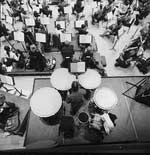Calgary's Model by Natasha Gauthier
/ September 3, 2003
Version française...
 Less than a year ago, the Calgary Philharmonic was
just another orchestra on the brink of collapse. Staggering under the load of a
million-dollar deficit, the CPO filed for bankruptcy protection last October and
suspended concerts for 45 days. Less than a year ago, the Calgary Philharmonic was
just another orchestra on the brink of collapse. Staggering under the load of a
million-dollar deficit, the CPO filed for bankruptcy protection last October and
suspended concerts for 45 days.
Flash forward 11 months. Ticket sales are booming,
all excess fat has been trimmed, the coffers are being steadily replenished and
the whole organization is buzzing with the voltage supplied by its new president
and CEO, Mark Bregazzi.
"I'm truly am feeling very optimistic," says
Bregazzi over the phone, just 34 days into his job. The CPO lured the
66-year-old former CEO of Gulf Canada from retirement in late June. "I'm a
high-energy type of guy, and this felt like the right challenge for
me."
One of Bregazzi's first tasks was to chart an
ambitious new course for the orchestra, which emerged from bankruptcy protection
in February. One of the new strategic plan's focuses is on increasing seat sales
through a combination of traditional concerts and new, community-programming
initiatives, such as concerts in nearby Banff and Lethbridge and participation
in events like Asian Heritage Month.
"We want to get more bottoms in seats," Bregazzi
states. "The goal is to have 50% of our revenues coming from ticket sales within
three years. It's something nobody has been able to do, but we feel quite
confident."
To help achieve this goal, Bregazzi says the CPO
has made it much easier to subscribe: "People can now pick and choose whatever
concerts they like instead of having to take one from this series and one from
that series, as was the case before. But we aren't just focussing on
subscriptions; we want to increase single ticket sales too."
Recent sales figures indicate that the new
management is on the right track. By July, the orchestra had already earned $1
million in advance ticket sales, and Bregazzi is proud to note that not a penny
will be spent until performances begin.
"I'm not a fiscal conservative, I'm a fiscal
miser," he says. "This organization had already been pared down to the bone when
I got here, and in some cases into the bone. But non-essential, that is to say
offstage, costs will be kept to a bare minimum. We've done no re-hiring.
Anything that doesn't absolutely need to be done from within will be outsourced.
It's just good business practice."
Bregazzi says the main spending priority is getting
the orchestra itself back up to speed. "There will be no compromise when it
comes to the core of what we do, the performances," he says. "We are in the
process of completing auditions and we will be operating with our full
complement of 65 musicians. Our season for this year is 38 weeks, and we have
plans to increase that by one week each year over the next three years, up to a
41-week season."
Bregazzi says the orchestra will also be increasing
the size of its chorus, although members will still have to pay a fee for the
privilege of singing.
There has been a growing trend in recent
years for arts organizations to hire their directors from the business
community. While some find the transition from the corporate to the cultural
sector difficult, Bregazzi says he has been impressed both with his welcome and
with the quality of the work done by the administration before his arrival.
However, he has noticed one major difference from his days in the oil and gas
business. "I'm amazed by the plethora of special-interest groups," he laughs,
listing the unions, the Friends of the orchestra, the volunteers, the donors,
and so on. "Of course, we know they're all special, but some like to believe
they're more special than others." Natasha
Gauthier
Version française... | 

